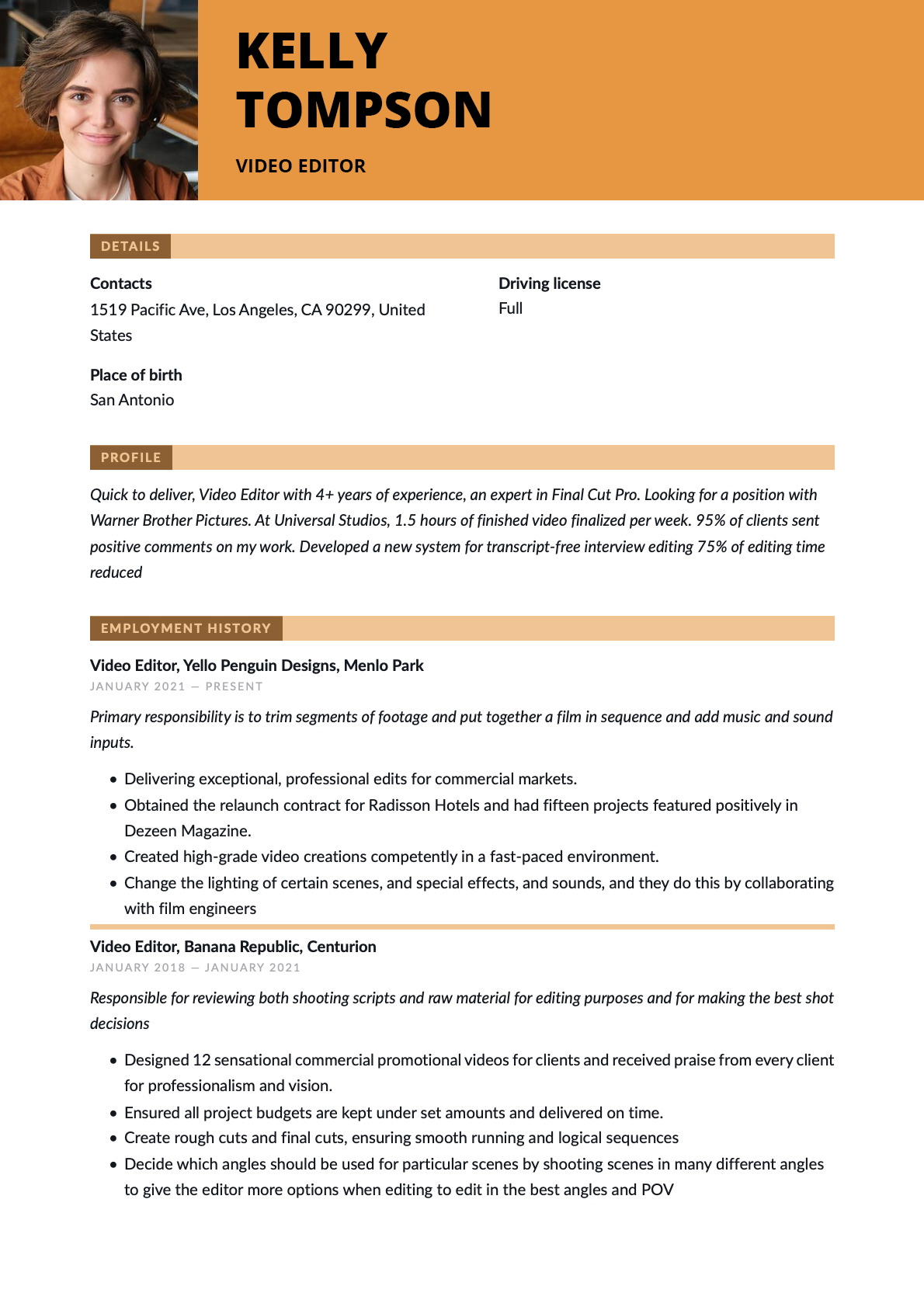
Freelance video editing offers a great career opportunity. As video content becomes increasingly popular, companies of all sizes need talented editors to create engaging visuals. We’re always searching for passionate editors to join our team and create video content for promo or influencing materials.
Freelance video editors are in high demand, cooperating with clients from various industries. They can assist with promotional projects, film post-production, and more. If you dream of becoming a video editor but lack experience, learn about different methods to develop your talents and establish yourself as a successful professional.
I remember the days when I took the first steps in my career and was looking for freelance video work prospects. It took commitment, learning new skills, and experimenting to reach where I am today. Now, I work as a video editor at FixThePhoto. In this guide, I’ll share my experiences and tips on how you can succeed as a freelance video editor.
A freelance video editor reviews raw video footage and makes edits to adjust the length, sound, and overall quality. They work on a contract basis for various clients rather than being employed by one company. Their tasks include creating promotional videos for different organizations, editing event footage, and collaborating on films for independent filmmakers and studios.
If you want to start, you should also be prepared to help capture memories at events like weddings or corporate gatherings by creating music videos.
Many industries rely on freelancing video editors to fulfill their video production needs. Typical tasks include:
Unlike some jobs, to start as a freelancer, you don’t need specific qualifications like a bachelor’s degree. Although some accreditation can be helpful, having video editing experience is more important.
There are some basic requirements that clients have when they want to hire a videographer or video editor. According to the Indeed platform, the key demands are:

As you begin your career as a freelance video editor, focus on accumulating clients and building a video editing portfolio. As your career progresses, you may have more opportunities to choose the jobs you want to work on and control how much money you earn. Here are some steps you can take to begin and grow a career in freelance video editing.
Your video editor freelance portfolio can be a YouTube channel or a website where you showcase your videos. A YouTube channel helps you share your work across different platforms, acting as a marketing tool. A website is more traditional and customizable, where you can include contact information for potential clients to reach you.
Look at these tools to create a portfolio: Wix, Vimeo, and Squarespace. Also, Behance is a good platform to showcase a portfolio of a freelance video editor. These platforms let you create pages with video embeds and detailed descriptions, and you can use the “Collections” feature to group related projects together.
Get comfortable using video editing program by making sample videos to improve your skills. Keep learning through tutorials, trade publications, and online forums. Pay attention to various Adobe Premiere Pro tutorials, which help improve video editors’ skills.
There are many great platforms for finding freelance video editor jobs locally, nationally, and internationally. Online job boards, video-specific Slack groups, and gig websites like Fiverr can help you build your professional profile and get more freelance work.
LinkedIn is also important for making connections. It lets you apply for jobs and put your name, face, and portfolio in front of potential clients and collaborators.
Over time, you’ll need a clear strategy to work more effectively with clients. Make sure you understand the following business functions:
Freelance video editing can pay well, especially as you gain experience. However, your income depends on several factors:
Location. Editors in cities like LA and New York typically charge higher rates than in other places.
Specialization. Editing specific types of videos, such as fashion or startup promos, can command higher fees compared to editing shorter clips.
Portfolio and skills. Just like in freelance photography, your work speaks for itself. The more impressive projects you have in your portfolio, the more you can charge.
Type of client. Larger brands usually have bigger budgets, allowing you to earn more per project. They also expect high-quality work.
Speed. Fast turnaround times often justify higher rates.
Online freelance markets. Use business freelance services like Upwork, Fiverr, and Freelancer, where you can create profiles, showcase your work, and bid on client projects.
Social media. Online platforms such as LinkedIn, Instagram, Facebook, and Twitter are valuable for sharing your video editing portfolio, interacting with potential clients, and joining relevant groups.
Industry events. Attend industry events, film festivals, workshops, and local meetups to network with potential clients and video editor freelance peers.
Website. Create a professional website or use platforms like Behance or Vimeo to display your portfolio, client feedback, and contact details.
Blogging. Optimize your website for search engines and write blog articles about video editing tips and past projects to drive organic traffic.
Specialized job boards. If you wonder how to get video editing jobs, check specialized job boards and websites like Indeed, Media Match, Mandy, and ProductionHUB that focus on creative and media roles.
YouTube and tutorials. Produce tutorials, vlogs, or demo reels on YouTube to demonstrate your skills and attract clients seeking proficient editors.
Collaborations. Collaborate with other freelancers, production companies, or agencies to access larger projects and maintain steady work opportunities.

As a freelance video editor, you’ll need a powerful computer with at least an Intel Core i7 processor, 16+GB of RAM, and a dedicated graphics card to handle demanding projects. Dual high-resolution monitors for video editing can greatly improve your workflow. Other devices include a keyboard, a precise mouse, a graphics tablet for detailed work, and high-quality headphones or studio monitors for accurate audio editing.
Freelance video editing prices depend on several factors, including experience, education, location, and specialized skills. For instance, an editor with nine years of experience who can create animations and motion graphics may charge more than a beginner still learning the basics. Example rate structures: Hourly rate: $25 to $150 per hour, depending on experience and skills. Project rate: $500 to $10,000 per project, depending on complexity.
Freelance video editors typically earn around $62,476 per year, with an average salary of $58,289 per year.
Start by learning the basics of video editing through online courses, tutorials, and reading materials.
We know that trying something new may be unsettling. So, to help you become a professional freelance video editor stress-free, our FixThePhoto team decided to share valuable tips and insights. Below, you can learn how to achieve recognition and earn top dollar for your video editing services.
Analyze the work of the pros. Examine the edits, transitions, and narrative techniques used by the best video editors in your industry. Pay attention to their video editing styles in films, ads, or viral videos. There are many tutorials that can come in handy.
Create your own projects. Practice new techniques and be open to experiments. Try your hand at editing a trailer, making a short film, or starting a vlog. To become a video editor, you may also participate in pet projects on Vimeo, Artella, or CollabFinder. This way, you can gain experience.
Memorize keyboard shortcuts. Learn the key combinations for your editing software, e.g., Premiere Pro keyboard shortcuts. Thus, you can streamline your video editing workflow and spend less time looking for the necessary tools and features.
It is paramount to comprehend the project’s concept. Each time to get a new project, read storyboards or scripts, and do your best to understand the editing flow and rhythm.
Take control of your files. Develop an efficient file management strategy. For instance, you can make folders with clear labels for raw video, audio, graphics, and project-related materials. By being organized, you can reduce search time and improve your overall productivity.
Get plug-ins and templates. Video editing becomes faster and easier with plug-ins and templates (e.g., for transitions or effects). You can purchase modern tools from Motion Array, Envato Elements, and Red Giant.
Create a reference library. Experienced freelance video editors have collections of royalty-free music, sound effects, stock footage, and motion graphics. Therefore, they can apply changes to videos faster and maintain consistency across multiple projects. Check out Behance, Vimeo, YouTube, TikTok, Dribble, and Reddit for inspiration.
Focus on rendering and export settings. Make sure you know the best export settings for YouTube, Instagram, broadcasting services, and other platforms. You should manipulate codecs, bitrates, and resolutions expertly.
Have regular respite. Video editing can be mentally taxing. To keep your creativity flowing and prevent burnout, take regular breaks. By spending time outside of video editing, you can give your mind a chance to rest and recharge. You’ll return with a renewed sense of inspiration and a fresh perspective.
Experiment with audio compositions. Never underestimate the power of sound in video editing. By experimenting with audio techniques - sound layering, ambient effects, and music syncing- you can create a more immersive and engaging viewing experience.

How to get a job as a video editor? Follow this guide to create a resume that highlights your unique talents and perfectly matches your target clients.
Contact details. Share your full name, phone number, email, and a link to the platform where potential clients can see your work (personal website, Vimeo, or YouTube).
Professional data. In just a few sentences, highlight your key skills, experience, and the types of projects you excel at (e.g., ‘Talented video editor specializing in corporate videos, YouTube content, and eye-catching ads’).
Skills section. Specify that you can use Adobe Premiere Pro, Final Cut Pro, DaVinci Resolve, and other programs. Mention that you are good at color grading, motion graphics, and sound design. Besides, you can write that you are a strong team player with excellent communication and organizational skills.

Work experience. List your freelance or employment history, highlighting your relevant projects:
Portfolio highlights. Share links to 3-5 projects that best represent your abilities. For each project, explain your role and responsibilities.
Education and certifications. Outline your degree(s) in fields like Film or Multimedia, and any industry-recognized certifications (e.g., Adobe Certified Professional).
Adjust your CV for each position. Customize your CV so that it matches the points described in the job offer.
Visual presentation. Stick to modern design styles so that your CV looks professional and neat. Use PDF format as it allows smooth sharing.